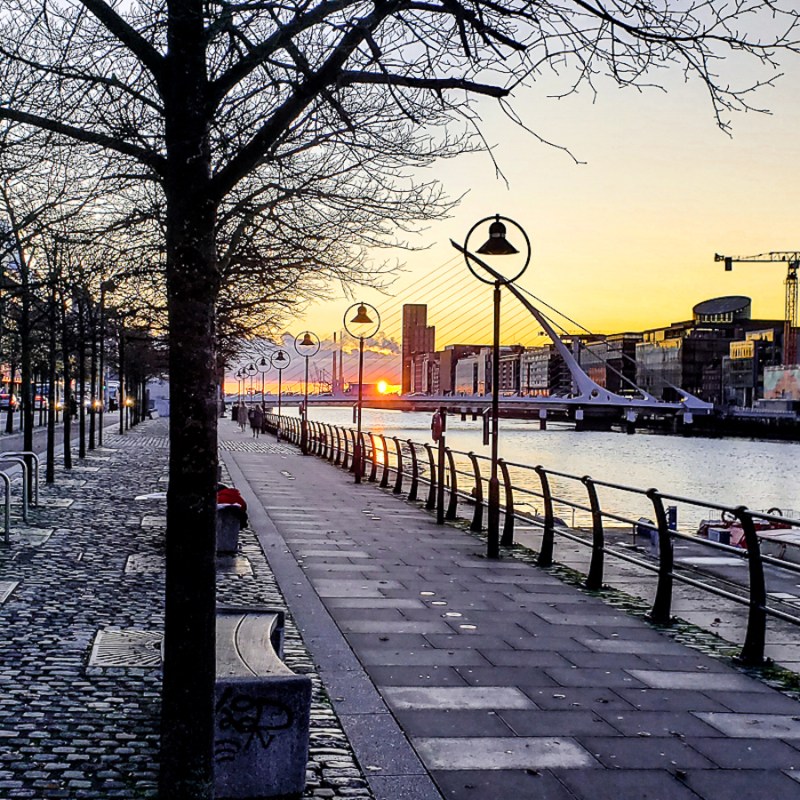
(Photo Credit: Kevin Scanlon)
Getting to know a city the size of Dublin can be challenging. Exploring culture, history, and meeting some locals for a little ‘”trad” and Guinness can be a haze of hurrying from place to place while spending more time in buses and taxis than experiencing Dublin.
Videos by TravelAwaits
My suggestion? Whether you have one day or a week to explore, narrow your activities to one neighborhood. Dig in and immerse yourself in a noteworthy walkable area.
I suggest the Temple Bar District. I promise you will fall in love with this central Dublin neighborhood overflowing with modern and traditional Ireland. Temple Bar is “Dublin’s culture center.” Within a square mile are 15 museums, galleries, studios, colleges, churches, parks, and performing arts schools. By night, it’s the life of the party.

(Photo Credit: Kevin Scanlon)
1. Sunrise Art And Architecture Walk
Put a sunrise walk along the River Liffey on your itinerary if you are a sunrise lover. It’s relatively quiet at sunrise, especially in the summer. As a result, auto and bus traffic is reduced. Sunday morning is ideal.
As you walk east along Bachelor’s Walk, you will see an eclectic mixture of architecture and art to your left. Surprising modern designs stand next to 400-year-old warehouses still in use. Sculpture and monuments along the way remember Ireland’s history.
On your right, the Liffey flows on its course to the Irish Sea. Boats are tied up along the quay, and a few are preparing for their day’s work. Some boats are for tours, and one is a restaurant. Across the river is more modern and traditional architecture snuggling up together.
I suggest starting at Frank Sherwin Bridge. Then, walk east along Bachelor’s Walk on the north side of the river. Take your time, stop for a coffee from a kiosk, then savor it on a bench. The walk ends at Dublin Bay and the Irish Sea for a total of about 3-miles one way.

(Photo Credit: Kevin Scanlon)
2. Walk The Temple Bar Heart
The inner heart of the Temple Bar District is Temple Bar. So, what is a Temple Bar? Good question. The name’s true origin isn’t clear. In the early 1600s, the Temple family built a home and gardens in the area, which may be the name’s source. But others say it was named for the Temple precinct in London, which has similar street names as the Dublin location.
At night, Temple Bar’s inner core is the center of nightlife especially appealing to a younger audience. On the main streets are tourist-focused pubs, restaurants, and nightclubs. Take a back street to find quieter places to eat or drink.
If nightlife isn’t your cup of tea, visit the inner district for lunch or an afternoon libation. It’s an entirely different personality, perfect for sipping, strolling, window shopping, and finding those souvenirs you want to take home. Chances are good that buskers will be performing, giving a taste of traditional Irish music.
The centuries-old neighborhood is bordered on the north by the River Liffey, on the south by Dame Street, to the east by Westmorland Street, and Fishamble Street to the west.
Pro Tip: Stop into the Temple Bar pub. It’s an excellent place for a pint and a selfie.

(Photo Credit: Mary Charlebois)
3. Experience EPIC
If you only have time for one thing in Dublin, you must visit EPIC — The Irish Emigration Museum. World Travel Awards has named EPIC “Europe’s Leading Tourist Attraction” for 3 consecutive years. In addition, EPIC gets my vote for the “Best Museum I’ve Experienced — Ever.”
EPIC’s exhibits and galleries are not a passive encounter. The story of 10-million Irish who emigrated from Ireland is told with multimedia using historical film, photos, and recordings combined with newly created materials. It is spectacular. The stories are passionate, hopeful, and sorrow-filled. While some exhibits will make you proud and joyful, others touch your heart with sadness. Be prepared with tissues. EPIC — The CHQ Building, Custom House Quay, Dublin.

(Photo Credit: Mary Charlebois)
4. Explore A Castle
Dublin Castle was the seat of the English/British from 1204 until 1922. The towers and walls protected the residence of the Viceroy of Ireland and were a ceremonial seat of government.
Today, the castle belongs to the Irish Government. It’s primarily used for state events but has many areas open to the public. Museums, galleries, gardens, state apartments, shops, and eateries occupy the extensive grounds.
A tour by a knowledgeable docent is a great way to start your castle experience. After the tour, you can return to areas where you want to dig a little deeper. There is also an audio guide available that can be downloaded to your phone for a self-guided tour. Dublin Castle is located off Dame Street in Central Dublin.
Pro Tip: The Castle Gardens are idyllic for a picnic.

(Photo Credit: Mary Charlebois)
5. Enjoy Some Black Stuff
Guinness Storehouse is the world’s most visited brewery, and it’s easy to see why. There is lots to do. You can tour the brewery, visit the Gravity Bar for 360-degree Dublin views, have a Connoisseur Experience, join the Guinness Academy, or have your selfie printed in the foam of your pint. If that’s not enough, you can visit their distillery and explore modern Irish whisky with cocktails, tastings, and workshops. Last but not least, enjoy pub-grub and small-batch brews at the Open Gate Brewery. Guinness Storehouse is on St. James’s Gate in Dublin.

(Photo Credit: Mary Charlebois)
6. Cross A Bridge Or Two
The River Liffey runs through the middle of Temple Bar District. 21 bridges cross the river carrying pedestrians and autos. Each bridge is different in style and function. As you crisscross the area, walk to the middle of a bridge for a great photo opp. Two of my favorites are…
The Ha’Penny Bridge (the official name is Liffey Bridge) is a footbridge built in 1816. The whimsical cast iron arched bridge was made in Shropshire, England. Ha’Penny was the first pedestrian bridge to cross the river, augmenting ferries. The name, ha’ penny, comes from the half penny toll charged for crossing the bridge.
Vehicles and pedestrians cross the Liffey on the Samuel Beckett Bridge. The movable bridge swings horizontally, allowing boats to pass up and down the river.
[07-St Stevens Green – Dublin ©Mary Charlebois.jpg]

(Photo Credit: Mary Charlebois)
7. Explore A Calm Oasis
Saint Stephen’s Green is in the center of Dublin. It’s a calm oasis in the middle of Dublin’s hustle and bustle. Yet Saint Stephen’s is more than a park. It’s a repository of 400-years of history, sculpture, and landscape.
The park’s landscaping has been maintained in its 1880 Victorian design. There’s a formal garden in the center of the green. Paths and lawns are symmetrical, leading to the park’s heart, two granite fountains. Over 750 trees, beds of seasonal flowers, border plantings, and footpaths fill the remainder of the 22-acre park. I was lucky enough to be there in the spring when the early spring bulb gardens were in their glory.
Throughout the common are sculptures and memorials honoring Irish heroes and artists. In addition, band stands often have performances. Spectators bring a blanket and sit on the lawn for the free events.
Urban wildlife is plentiful. I adored the graceful white swans on the lakes. While Saint Stephen’s is a birder’s paradise, mammals are often spotted — squirrels are most common. Still, foxes, mice, and rats live unseen by most park visitors.
An ideal way to get to know the park is the audio guide. 10 stops take about an hour with the guide on your phone or tablet. Here’s a little sample. I think you’ll find it informative and fascinating.

(Photo Credit: Kevin Scanlon)
8. Lunch At The Epic
Located in the CHQ Building, the EPIC is a world-class museum. Atop the EPIC in the CHQ Building is an outstanding food, shopping, and lifestyle mall. Lunch here can satisfy any taste, even a group with different tastes.
I found TOSS’D Noodles & Salads irresistible — more than once. As the name suggests, noodles and salads are the house specialties. The Thai chicken & coconut soup (tom kha gai) was a frequent choice. Creamy, sweet, spicy, hot, and delicious. The huge, under-10-euro bowl of slurpy goodness was what I needed for a misty afternoon of walking.

(Photo Credit: Mary Charlebois)
Getting There
If you plan to fly, you’ll arrive at Dublin International Airport (DUB). You can drive, take a taxi, or take a bus into the city.
If coming from England, take an auto or passenger ferry from Holyhead to Dublin. You can walk, bus, or taxi to Temple Bar from the port.
I suggest not driving. Like any big city, traffic is a bit anxiety-inducing, especially if left-side driving is new to you. Also, parking is scarce and expensive. A taxi will cost about 36 euros and take 30 to45 minutes. A bus from the airport to the Temple Bar District costs 8 euros and takes about 45 minutes. The bus has plenty of luggage room, Wi-Fi, and onboard toilets.
Dublin’s Public Transportation is efficient, inexpensive, and safe if you want to go further afield from Temple Bar. A Visitor Leap Card is the cheapest way to get around. It can be purchased online and used with your smartphone. Learn about Dublin’s buses, trains, trams, and cycle-friendly transit at Dublin Public Transit.
Pro Tip: Make this a walking holiday. Spending time on the streets and sidewalks puts you in touch with so much more. Temple Bar is made for walking. It’s safe, well mapped, and covered with Ireland’s history and future.

